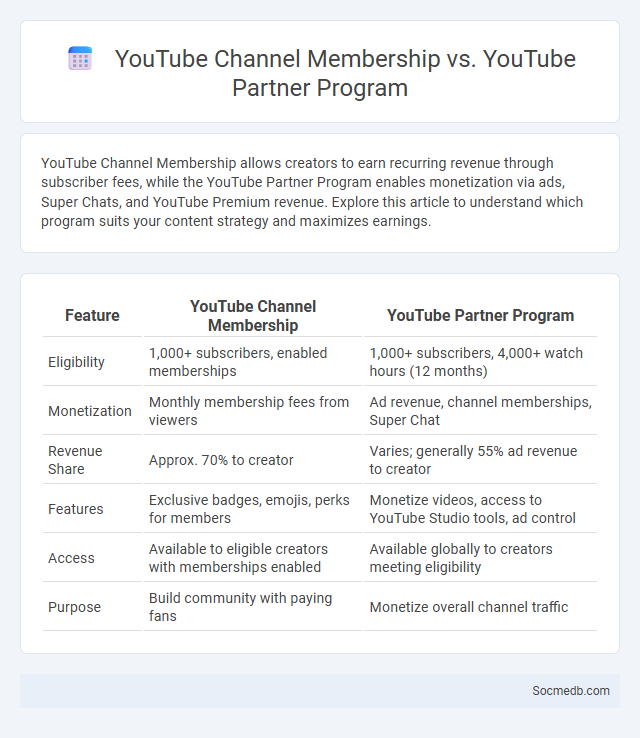
Photo illustration: YouTube Channel Membership vs YouTube Partners Program
YouTube Channel Membership allows creators to earn recurring revenue through subscriber fees, while the YouTube Partner Program enables monetization via ads, Super Chats, and YouTube Premium revenue. Explore this article to understand which program suits your content strategy and maximizes earnings.
Table of Comparison
| Feature | YouTube Channel Membership | YouTube Partner Program |
|---|---|---|
| Eligibility | 1,000+ subscribers, enabled memberships | 1,000+ subscribers, 4,000+ watch hours (12 months) |
| Monetization | Monthly membership fees from viewers | Ad revenue, channel memberships, Super Chat |
| Revenue Share | Approx. 70% to creator | Varies; generally 55% ad revenue to creator |
| Features | Exclusive badges, emojis, perks for members | Monetize videos, access to YouTube Studio tools, ad control |
| Access | Available to eligible creators with memberships enabled | Available globally to creators meeting eligibility |
| Purpose | Build community with paying fans | Monetize overall channel traffic |
Understanding YouTube Channel Membership
YouTube channel membership enables creators to build a dedicated community by offering exclusive perks such as badges, emojis, and members-only content. This feature drives consistent revenue streams through monthly subscriptions, enhancing channel monetization. Understanding YouTube's membership policies and utilizing member engagement analytics optimizes growth and fosters long-term supporter loyalty.
What Is the YouTube Partners Program?
The YouTube Partner Program (YPP) enables content creators to monetize their videos through ads, channel memberships, and merchandise shelves by meeting specific eligibility requirements such as 1,000 subscribers and 4,000 watch hours in the past 12 months. Creators gain access to advanced features like analytics, Copyright Match Tool, and support options to optimize channel growth and revenue. The program plays a crucial role in turning YouTube channels into sustainable businesses by providing multiple income streams directly tied to audience engagement and video performance.
Key Differences: Channel Membership vs YouTube Partners Program
Channel Membership offers viewers exclusive perks like badges, emojis, and members-only content for a monthly fee, directly supporting creators. The YouTube Partners Program enables creators to monetize their videos through ads, channel memberships, and merchandise shelf, requiring eligibility criteria such as 1,000 subscribers and 4,000 watch hours. Your choice between these depends on whether you want to build a loyal community with direct memberships or generate revenue through broader monetization options.
Eligibility Requirements for Each Program
Eligibility requirements for social media programs vary widely depending on the platform and specific initiative. Common criteria include age restrictions, with most platforms requiring users to be at least 13 years old, and geographic location, as some programs target users in specific countries or regions. Verification processes often require valid identification and active account status to qualify for monetization or partnership programs, ensuring compliance with community guidelines and content standards.
Revenue Streams: How Creators Earn with Each
Social media platforms generate diverse revenue streams for creators, including ad revenue sharing, brand partnerships, and direct fan support through subscriptions or tipping. Monetization tools like sponsored posts, affiliate marketing, and product placements further enhance creators' earning potential. Emerging features such as live-stream shopping and exclusive content unlock additional income channels tailored to audience engagement and platform algorithms.
Features and Benefits Comparison
Social media platforms offer diverse features such as live streaming, stories, and messaging that cater to varying user needs, enhancing real-time interaction and content sharing. These functionalities boost brand visibility, customer engagement, and data-driven marketing strategies, providing businesses with targeted advertising opportunities and measurable ROI. User-friendly interfaces and algorithm-driven feeds further personalize experiences, increasing time spent on platforms and fostering community building.
Monetization Tools: Perks, Ads, and More
Social media platforms offer diverse monetization tools such as ad placements, sponsored content, and subscriber perks to help creators generate revenue. Features like YouTube's Super Chat, Instagram's Shopping Tags, and TikTok's Creator Fund enable users to capitalize on audience engagement effectively. These tools optimize earning potential by blending seamless advertising integration with direct fan support.
Community Engagement Opportunities
Social media platforms provide numerous community engagement opportunities that help you build meaningful connections and foster loyalty. By leveraging interactive features such as live chats, polls, and user-generated content, brands can encourage active participation and create a sense of belonging among followers. Engaging authentically in these digital spaces enhances brand visibility and drives sustained interaction within your target audience.
Choosing the Right Option for Your Channel
Selecting the right social media platform for your channel requires analyzing your target audience's demographics and content preferences to maximize engagement. You should prioritize platforms where your audience is most active, such as Instagram for visual storytelling or LinkedIn for B2B networking. Tailoring your strategy to each channel's unique features enhances your content's reach and boosts your channel's overall growth.
Frequently Asked Questions (FAQ)
Social media FAQs often address key topics such as account setup, privacy settings, content sharing policies, and troubleshooting common issues related to login and notifications. Users seek clarity on platform-specific features, data security measures, and how to manage interactions or report inappropriate content effectively. Understanding these frequently asked questions enhances user experience and promotes safe, informed social media engagement.
 socmedb.com
socmedb.com